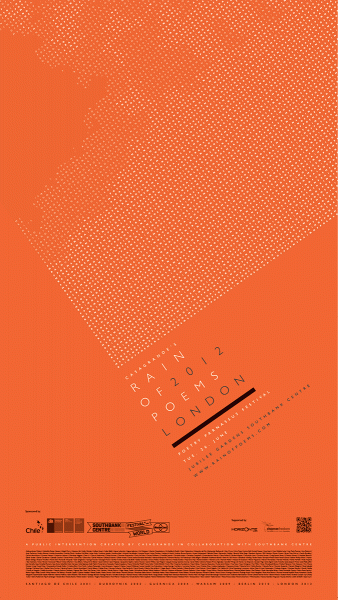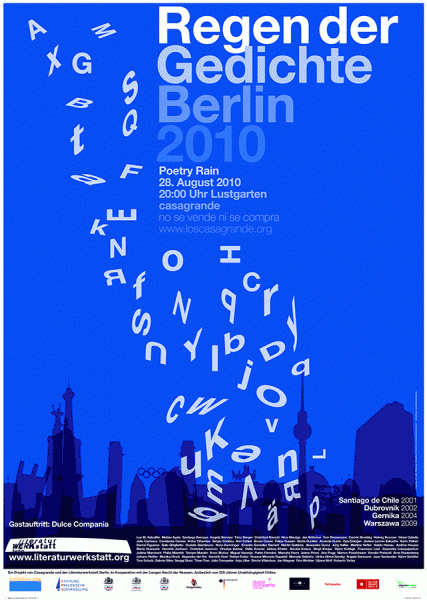Colectivo CASAGRANDE
Poems not bombs

On March 23, 2001, in the middle of the first international poetry festival known as “Chile Poesía” celebrated in Santiago (featuring important writers such as Ernesto Cardenal, Juan Gelman, Antonio Cisneros, Adrienne Rich, Rita Dove, Yevgueni Yevtushenko, Hans Magnus Enzensberger, Nicanor Parra, and Raúl Zurita, among others), three members of the local collective CASAGRANDE performed the very first of a series of “site-specific interventions” that are now worldwide known as “Bombardeo de Poemas” (“Poetry bombings” or “Rain of poems”). The idea was pretty simple, at least in the paper: the collective would bomb the crowd attending the last reading of “Chile Poesía” with poems. The poems would be thrown in the form of bookmarks, and the dropping would be done from a helicopter or small aircraft.

After thirteen years of regained democracy, the project stood as a way to respond to the need to reconcile the violent history of La Moneda, the Presidential Palace, which had recently opened its doors to the general public after approximately thirty years of being shut. That night, during the closing reading of “Chile Poesía,” hundreds of people were standing in La Plaza de la Constitución (Constitution Square) listening to the poets who were reading from the same balcony from where Salvador Allende used to wave to his supporters, and probably the same balcony from which he resisted Pinochet’s coup by firing his AK-47 against the soldiers and tanks that were taking the square. That particular location posed special difficulties for the action, mainly because of four legal dispositions that had to be circumvented: 1) Prohibition to fly over a crowd, 2) Prohibition to fly by night, 3) Prohibition of throwing objects from the air, and 4) Strict prohibition of using the airspace of La Moneda Palace (which had been flown over only once in its history: on September 11, 1973, when two Hawker Hunters bombed and destroyed the palace).

Despite the regulations, the mission was a complete success: a helicopter showed up just after the readings, and a rain of bookmarks containing poems from the guests of Chile Poesía and young Chilean writers began to fall. The reaction of the public was spontaneous and unanimous. According to a local chronicle of the time, “an inexplicable joy followed the amazement. Raising their hands up, people playfully fought for the bookmarks.” The crowd assimilated the bombing as a celebration. The work that was enacted and erased in a few minutes was able to eclipse the pain through the simple gesture of taking another look to the sky. By appropriating the operation of a military bombing, CASAGRANDE turned word into image, expanding it in order to occupy the space of the square while taking symbolically the use of violence, resignifying it into a radical openness of memory.
The performance was so popular that even the writer and filmmaker Alejandro Jodorowsky had something to say about it: “Memory can be changed: the events that have been lived tragically rest in the brain as images that can be exalted when healthy elements are added. The Presidential Palace had been turned by the military into a place populated by anguish. By irrigating it with poetry, the members of CASAGRANDE converted it into a spiritual place. Before the bombing La Moneda was a barren grave. After the bombing it was transformed into the heart of a spiritual change that will affect the whole world. Young people from all over the planet will imitate CASAGRANDE, they will sow poetry in battlefields, in jails, in the polluted cities …”

But Santiago was just the beginning. Others cities were “bombed” and intervened in a similar way too. They were all cities that had experienced aerial bombings in the past, like Dubrovnik (shelled on December 6, 1991, by Serbian and Montenegrin forces; bombed with poems in 2002), Guernica (bombed by the Luftwaffe on April 26, 1937; bombed with poems in 2004), Warsaw (destroyed during World War II; bombed with poems in 2009), Berlin (devastated during World War II; bombed with poems in 2010), and London (destroyed during World War II; bombed with poems in 2012).
The modus operandi of the performance was the same in every city: dropping 100,000 poems printed on bookmarks from an aircraft over the crowd. The bookmarks, printed in two languages, written both by Chilean writers and poets native to the location of the bombing, were released at twilight, and the results were always the same: “each time, every single bookmark was picked up by the crowd. People began to exchange the bookmarks, turning them into coveted goods for barter rather than litter.”
According to CASAGRANDE, the “Rain of Poems” proposes to be a gesture of remembrance in the present but also a metaphor for survival (of cities and people). It respects both the victims of the traumatic experience of an air bombing, and those ethical questions behind the context of warfare in which the decision to deploy such weapons is made. These proposals are articulated within the context of a symbolic event that can open up a new discursive space, one that goes beyond familiar discourses of remembrance of past events. The project creates a debate between cities, art practices, and texts that orientate memories of conflict towards a different future.

As Santiago Barcaza, one of the members of CASAGRANDE, stated recently at the launch party for the book that gathers all the bookmarks used in London’s Rain of Poems: “the idea is more about the compensation of a loss rather than searching for an origin. Instead, the bombings act as the writing of that loss. The gesture is not installed from the conflict itself or from the denial of historical facts, but it creates a new way of observation, another way of seeing, understanding that it will never achieve an overcoming synthesis. It’s just a manner of understanding life, a kind of healing at best, which only lasts a couple of minutes. Good enough to whisper into somebody’s ear or to look at the sky while the poems are falling.”
Daniel Opazo Ortiz in his work “Operaciones Escultóricas en la Plaza de la Constitución, Santiago de Chile” (Sculptural Operations at Constitution Square, Santiago, Chile) remarks that throwing poems over a bombed city has multiple readings: it could be taken as the exorcism of a landmark, or as the recovering of the role of poetry in civic life, but it also works as a sort of ritual of mass reading, in which the cloud of poems suspended in the air acts as a book with many pages that are read all at once. In a way, the “Bombings of Poems” resemble the works of the guerrilla poetry groups described in Kaia Sand and Jules Boykoff’s “Landscape of Dissent,” inasmuch as they also take over public space, turning it into a political space by displaying poetry out of the context of a book, resignifying the historical landscape through an action based on written words and community participation.
The “bombings” also find inspiration in and are intimately linked to other local sources such as the performance “Ay Sudamérica” by CADA and the long poem “La Ciudad” by Gonzalo Millán. I will comment on the latter in a future post.
Find more info about CASAGRANDE here. More info about the project “Bombing of Poems” here. More videos of the bombings here.
Chilean poetics